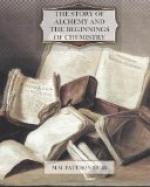“If any one would enter upon the practices of Chymistry, let him apply himself to some expert artist for to be instructed in the manual operation of things; for by this means he will learn more in two months, than he can by his practice and study in seven years, as also avoid much pains and cost, and redeem much time which else of necessity he will lose.”
Fig. VIII. p. 82, represents a common cold still, and Fig. IX. p. 84, is a sketch of an apparatus for distilling by the aid of boiling water. The bath wherein the vessels are placed in Fig. IX. was called by the alchemists balneum Mariae, from Mary the Jewess, who is mentioned in the older alchemical writings, and is supposed to have invented an apparatus of this character. Nothing definite is known of Mary the Jewess. A writer of the 7th century says she was initiated in the sacred art in the temple of Memphis; a legend prevailed among some of the alchemists that she was the sister of Moses.
Fig. X. p. 85, represents methods of distilling with an apparatus for cooling the volatile products; the lower vessel is an alembic, with a long neck, the upper part of which passes through a vessel containing cold water.
[Illustration: Fig XIII. See p. 94.]
Fig. XI. p. 88, shows a pelican, that is a vessel wherein a liquid might be heated for a long time, and the volatile products be constantly returned to the original vessel.
Fig. XII. p. 89, represents a retort with a receiver.
Some of the pieces of apparatus for distilling, which are described by French, are shown in the following figures. Besides describing apparatus for distilling, subliming, and other processes in the laboratory, French gives directions for making tinctures, essences, essential oils, spirits of salt, and pure saltpetre, oil of vitriol, butter of antimony, calces (or as we now say, oxides) of metals, and many other substances. He describes processes for making fresh water from salt, artificial mineral water, medicated hot baths for invalids (one of the figures represents an apparatus very like those advertised to-day as “Turkish baths at home"), and artificial precious stones; he tells how to test minerals, and make alloys, and describes the preparation of many substances made from gold and silver. He also gives many curious receipts; for instance, “To make Firre-trees appear in Turpentine,” “To make a Plant grow in two or three hours,” “To make the representation of the whole world in a Glass,” “To extract a white Milkie substance from the raies of the Moon.”
[Illustration: FIG. XIV. See p. 94.]
The process of making oil of vitriol, by burning sulphur under a hood fitted with a side tube for the outflow of the oil of vitriol, is represented in Fig. XIII. p. 92.




